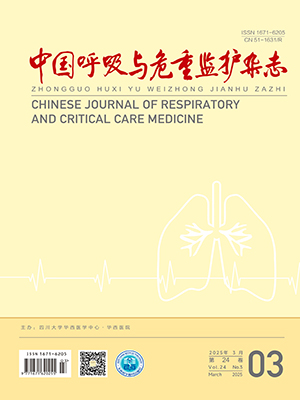Objective To analyze the clinical and etiological characteristics and bacterial susceptibility in patients with ventilator-associated pneumonia (VAP) in Guangzhou area.Methods A retrospective study was conducted on VAP patients in four hospital of Guangzhou from Jan 2004 to Oct 2005.Totally 157 patients were enrolled in this study,whose flora was identified and tested by Kirby Bauer disk diffusion susceptibility test.The univariate analysis method was used to analyze the prognostic parameters.Results The average onset time of VAP was 7.7 days after mechanical ventilation with a mortality rate of 38.2%.The proportion of Gram-negative bacilli,Gram-positive cocci and eumycete was 68.0%,23.4% and 8.7% respectively in 184 isolated strains.The most common pathogens were Pseudomonas aeruginosa (18.5%),Stenotrophomonas maltophilia (14.1%),Burkholderia cepacia (10.9%),Staphylococcus aureus (10.3%) and Acinetobacter baumannii (8.7%).Pseudomonas aeruginosa,Stenotrophomonas maltophilia,and Acinetobacter baumannii were resistant to most common antibacterials such as cephalosporin and imipenem.18 strains oxacillin resistant Staphylococcus aureus,7 strains oxacillin resistant Staphylococcus simulans and one vancomycin resistant Staphylococcus aureus were isolated.Expect for vancomycin,teicoplanin and fusidic acid,the resistance of Gram-positive cocci were above 50% to other 9 antibacterials.Conclusions The antibiotic resistance situation of VAP in Guangzhou is very serious with high mortality.It is important to reinforce the prevention and guidance on the proper treatment of VAP.
Citation:
LIU Zhaohui,CHEN JingLong,XIE Changjiang,MA Hongming,ZHOU Yuming CorrespondingAuthorLIU Zhaohui,EmailGzzhaohuiliusina.com. Clinical epidemiological study and etiological analysis of ventilator-associated pneumonia in Guangzhou area. Chinese Journal of Respiratory and Critical Care Medicine, 2007, 6(2): 93-96. doi:
Copy
Copyright © the editorial department of Chinese Journal of Respiratory and Critical Care Medicine of West China Medical Publisher. All rights reserved
| 1. |
Bauer TT,Ferrer R,Angrill J,et al.Ventilator-associated pneumonia:incidence,risk factors,and microbiology.Semin Respir Infect,2000,15:272-279.
|
| 2. |
American Thoracic Society;Infectious Diseases Society of America.Guidelines for the management of adults with hospital acquired,ventilator associated,and healthcare associated pneumonia.Am J Respir Crit Care Med,2005,171:388-416.
|
| 3. |
中华医学会呼吸病学分会.医院获得性肺炎诊断和治疗指南(草案).中华结核和呼吸杂志,1999,22:201-203.
|
| 4. |
Safdar N,Crnich CJ,Maki DG.The pathogenesis of ventilator-associated pneumonia:its relevance to developing effective strategies for prevention.Respir Care,2005,50:725-741.
|
| 5. |
Keenan SP,Heyland DK,Jacka MJ,et al.Ventilator-associated pneumonia.Prevention,diagnosis,and therapy.Crit Care Clin,2002,18:107-125.
|
| 6. |
甘枚,黄捷敏.呼吸机相关肺炎危险因素探讨.中国呼吸与危重监护杂志,2006,5:175-177.
|
| 7. |
李华茵,何礼贤,胡必杰,等.重症监护病房呼吸机相关性肺炎临床与病原学分析.中国呼吸与危重监护杂志,2005,4:266-270.
|
| 8. |
陈吉泉,修清玉,颜泽敏.45例机械通气相关肺炎的临床分析.中华结核和呼吸杂志,2003,42:282-283.
|
| 9. |
叶惠芬,刘平,杨银梅,等.广州地区肠杆菌属高产AmpC酶和超广谱β-内酰胺酶的调查.中国抗生素杂志,2004,29:601-602,622.
|
| 10. |
王汉平,刘朝晖,杨银梅,等.产TEM-116型β-内酰胺酶的肺炎克雷伯菌耐药性研究.中华医院感染学杂志,2006,16:365-367.
|
| 11. |
刘朝晖,王汉平,杨银梅,等.广州地区产ESBL肺炎克雷伯菌SHV型质粒的分子流行病学调查.中华微生物学和免疫学杂志,2006,26:939-943.
|
- 1. Bauer TT,Ferrer R,Angrill J,et al.Ventilator-associated pneumonia:incidence,risk factors,and microbiology.Semin Respir Infect,2000,15:272-279.
- 2. American Thoracic Society;Infectious Diseases Society of America.Guidelines for the management of adults with hospital acquired,ventilator associated,and healthcare associated pneumonia.Am J Respir Crit Care Med,2005,171:388-416.
- 3. 中华医学会呼吸病学分会.医院获得性肺炎诊断和治疗指南(草案).中华结核和呼吸杂志,1999,22:201-203.
- 4. Safdar N,Crnich CJ,Maki DG.The pathogenesis of ventilator-associated pneumonia:its relevance to developing effective strategies for prevention.Respir Care,2005,50:725-741.
- 5. Keenan SP,Heyland DK,Jacka MJ,et al.Ventilator-associated pneumonia.Prevention,diagnosis,and therapy.Crit Care Clin,2002,18:107-125.
- 6. 甘枚,黄捷敏.呼吸机相关肺炎危险因素探讨.中国呼吸与危重监护杂志,2006,5:175-177.
- 7. 李华茵,何礼贤,胡必杰,等.重症监护病房呼吸机相关性肺炎临床与病原学分析.中国呼吸与危重监护杂志,2005,4:266-270.
- 8. 陈吉泉,修清玉,颜泽敏.45例机械通气相关肺炎的临床分析.中华结核和呼吸杂志,2003,42:282-283.
- 9. 叶惠芬,刘平,杨银梅,等.广州地区肠杆菌属高产AmpC酶和超广谱β-内酰胺酶的调查.中国抗生素杂志,2004,29:601-602,622.
- 10. 王汉平,刘朝晖,杨银梅,等.产TEM-116型β-内酰胺酶的肺炎克雷伯菌耐药性研究.中华医院感染学杂志,2006,16:365-367.
- 11. 刘朝晖,王汉平,杨银梅,等.广州地区产ESBL肺炎克雷伯菌SHV型质粒的分子流行病学调查.中华微生物学和免疫学杂志,2006,26:939-943.




